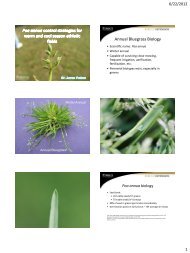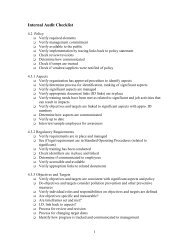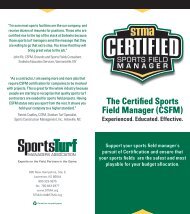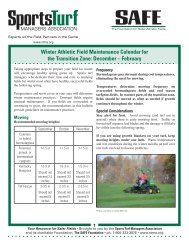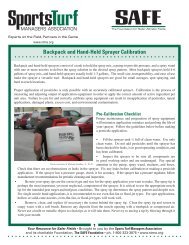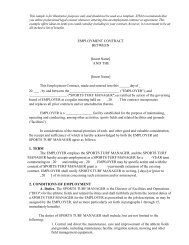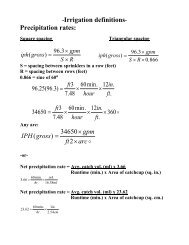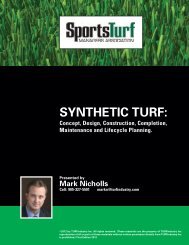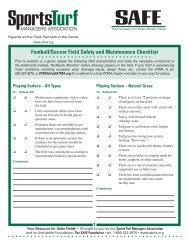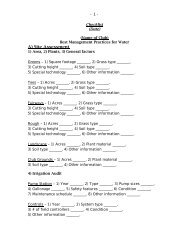The STMA Collection of ASTM Standards for Athletic Fields
The STMA Collection of ASTM Standards for Athletic Fields
The STMA Collection of ASTM Standards for Athletic Fields
You also want an ePaper? Increase the reach of your titles
YUMPU automatically turns print PDFs into web optimized ePapers that Google loves.
www.stma.org<strong>The</strong> <strong>STMA</strong> <strong>Collection</strong> <strong>of</strong> <strong>ASTM</strong> <strong>Standards</strong> <strong>for</strong> <strong>Athletic</strong> <strong>Fields</strong><strong>ASTM</strong> International is one <strong>of</strong> the largest voluntary standards development organizations in the world. It hasbecome a trusted source <strong>for</strong> technical standards <strong>for</strong> materials, products, systems and services, and it guides design,manufacturing and trade in the global economy.<strong>STMA</strong>, with the support <strong>of</strong> its charitable foundation, SAFE, has compiled the <strong>ASTM</strong> standards recommended<strong>for</strong> athletic field facilities into this convenient, at-a-glance collection. <strong>STMA</strong>’s goal is to provide its members within<strong>for</strong>mation to help them produce safe, playable surfaces to maximize the per<strong>for</strong>mance <strong>of</strong> the field and protectathletes. <strong>The</strong>se standards address important safety issues as well as testing and proper construction <strong>of</strong> athleticfield surfaces.<strong>STMA</strong> is the not-<strong>for</strong>-pr<strong>of</strong>it, pr<strong>of</strong>essional association <strong>for</strong> the men and women who manage sports fields. Its 2,800members oversee sports fields and facilities at schools, colleges and universities, parks and recreational facilities,and pr<strong>of</strong>essional sports stadiums. Since 1981, the association and its dozens <strong>of</strong> local chapters have been providingeducation, in<strong>for</strong>mation and sharing practical knowledge in the art and science <strong>of</strong> sports field management.Instructions on how to purchase these standards on the <strong>ASTM</strong> website can be found on the last page.Standard Test Methods <strong>for</strong><strong>Athletic</strong> Field RootzonesParticle Size Analysis and Sand Shape Grading<strong>of</strong> Golf Course Putting Green and Sports FieldRootzone MixesThis test method covers the determination <strong>of</strong> particle sizedistribution <strong>of</strong> sand-based root- zone mixes. Particleslarger than 0.05 mm are determined by sieving. <strong>The</strong> siltand clay percentages are determined by a sedimentationprocess. This procedure was developed <strong>for</strong> putting greenrootzone mixes, those assumed to have sand contents <strong>of</strong> 80% by weight or greater. This test method also describes aqualitative evaluation <strong>of</strong> sand particle shape.Designation: F1632-10Organic Matter Content <strong>of</strong> <strong>Athletic</strong> FieldRootzone MixesThis test method outlines laboratory procedures <strong>for</strong> determiningthe amount <strong>of</strong> organic matter in a sports turf rootzonemix.Designation: F1647-11Saturated Hydraulic Conductivity, Water Retention,Porosity, and Bulk Density <strong>of</strong> <strong>Athletic</strong> Field Rootzones<strong>The</strong>se test methods cover the measurements <strong>of</strong> saturatedhydraulic conductivity, water retention, porosity, and bulkdensity on sand-based root zone mixes to be used <strong>for</strong> construction<strong>of</strong> sand-based sports fields, or other highly traffickedturfgrass areas. <strong>The</strong>se test methods are designed <strong>for</strong>sand-based mixes and are not intended <strong>for</strong> use with fine ormedium textured soils, <strong>for</strong> example, sandy loams and loams.Designation: F1815-111Your Resource <strong>for</strong> Safer <strong>Fields</strong> • Brought to you by the Sports Turf Managers Associationand its charitable Foundation, <strong>The</strong> SAFE Foundation • ph. 1-800-323-3875 • www.stma.org
<strong>The</strong> <strong>STMA</strong> <strong>Collection</strong> <strong>of</strong> <strong>ASTM</strong> <strong>Standards</strong> <strong>for</strong> <strong>Athletic</strong> <strong>Fields</strong>Shock-Absorbing Properties <strong>of</strong> Playing SurfaceSystems and MaterialsThis test method covers the measurement <strong>of</strong> certain shockabsorbingcharacteristics, the impact <strong>for</strong>ce-time relationships,and the rebound properties <strong>of</strong> playing surfacesystems. This test method is applicable to natural and artificialplaying surface systems and to components there<strong>of</strong>.Typical playing surfaces are wrestling mats, football fields,soccer fields, playgrounds, and so <strong>for</strong>th.Designation: F355-10aEvaluating the Force Reduction Properties <strong>of</strong> Surfaces<strong>for</strong> <strong>Athletic</strong> UseThis test method measures the <strong>for</strong>ce reduction properties<strong>of</strong> a surface used <strong>for</strong> athletic activity. It may be an indicator<strong>of</strong> the per<strong>for</strong>mance, safety, com<strong>for</strong>t, or suitability <strong>of</strong>the surface.Designation F2569-11Standard Specification <strong>for</strong> Impact Attenuation <strong>of</strong> TurfPlaying Systems as Measured in the FieldThis specification covers a test method and the correspondingper<strong>for</strong>mance requirement <strong>for</strong> the maximum impact attenuationin all types <strong>of</strong> turf playing systems installed <strong>for</strong>North American football fields that is intended to establisha method <strong>for</strong> identifying and reporting areas within anexisting playing system where shock-absorbing propertiesexceed recommended threshold values. Testing applies tosynthetic turf systems with resilient padding, natural turfsystems, combination turf systems, and infill synthetic turfsystems.Designation F1936-10Standard Terminology Relating to Impact Testing <strong>of</strong>Sports Surfaces and EquipmentThis terminology covers terms related to impact test methodsand impact attenuation specifications <strong>of</strong> sports equipmentand surfaces.Designation F2650-07Standard Guides <strong>for</strong> Synthetic SurfacesStandard Specification <strong>for</strong> Total Lead Content inSynthetic Turf FibersThis specification applies to the maximum content <strong>of</strong> leadin fibers used in synthetic turf. This specification outlinesa test method <strong>for</strong> sample preparation and a test method <strong>for</strong>analyzing the total lead content in synthetic turf fibers.This specification outlines guidelines <strong>for</strong> reporting totallead content in synthetic turf fibers. This specification appliesonly to synthetic turf fibers manufactured after Sept.1, 2009.Designation: F2765-09Standard Test Method <strong>for</strong> Relative Abrasiveness <strong>of</strong>Synthetic Turf Playing SurfacesThis test method is applicable to both laboratory and fieldmeasurement <strong>of</strong> synthetic turf surfaces used <strong>for</strong> sports.Data obtained from the procedure <strong>of</strong> this test method areindicative <strong>of</strong> the relative abrasiveness <strong>of</strong> fabric or carpettype synthetic playing surfaces.Designation: F1015-03(2009)Standard Test Methods <strong>for</strong> ComprehensiveCharacterization <strong>of</strong> Synthetic Turf Playing Surfacesand Materials<strong>The</strong>se test methods are used to identify physical propertycharacteristics and comparison <strong>of</strong> the per<strong>for</strong>mance properties<strong>of</strong> synthetic turf systems or components <strong>for</strong> athleticand recreational uses, or both.Designation: F1551-09Standard Test Method <strong>for</strong> Permeability <strong>of</strong> SyntheticTurf Sports Field Base Stone and Surface System byNon-confined Area Flood Test MethodThis test method can be used to determine in-place permeability<strong>of</strong> synthetic turf playing field systems, playing fieldsystems with pad and/or premolded drainage boards, playingfield systems with premolded panel base systems, porousand non porous pavement systems in order to confirmcompliance with design specifications and or evaluate existingas-built conditions. Synthetic turf field systems tendto drain under several flow regimes and this test methodcan provide a clear indication <strong>of</strong> actual in-field permeabilityflow rates with limited effect <strong>of</strong> lateral flow throughbase systems and no effect from head pressure.Designation: F2898-113Your Resource <strong>for</strong> Safer <strong>Fields</strong> • Brought to you by the Sports Turf Managers Associationand its charitable Foundation, <strong>The</strong> SAFE Foundation • ph. 1-800-323-3875 • www.stma.org
<strong>The</strong> <strong>STMA</strong> <strong>Collection</strong> <strong>of</strong> <strong>ASTM</strong> <strong>Standards</strong> <strong>for</strong> <strong>Athletic</strong> <strong>Fields</strong>Standard Specification <strong>for</strong> Synthetic SurfacedRunning TracksThis specification establishes the minimum per<strong>for</strong>mancerequirements, classification, and test methods <strong>for</strong> syntheticsurfaced running tracks. <strong>The</strong> requirements <strong>for</strong> which newlyinstalled synthetic surfaces shall be tested on and consequentlycomply to are imperfections, evenness, thickness,drainage, <strong>for</strong>ce reduction, modified vertical de<strong>for</strong>mation,texture influence when wet, tensile properties, color in greyscale, weathering, spike resistance, and flammability.Designation F2157-09Work Items Under Development by <strong>ASTM</strong>:New Guide <strong>for</strong> Characterizing Per<strong>for</strong>manceProperties <strong>of</strong> Synthetic Turf SystemsThis guide establishes a recommended list <strong>of</strong> standardsand specifications <strong>for</strong> characterizing the per<strong>for</strong>manceproperties <strong>of</strong> synthetic turf systems. This guide can beused by sport governing bodies or other groups that specifythe per<strong>for</strong>mance requirements <strong>for</strong> synthetic turf systemsused <strong>for</strong> athletic competition.Designation: WK15822New Guide <strong>for</strong> Specifying, Measuring, and ManagingImpact Attenuation <strong>of</strong> Synthetic Turf Playing SystemsThis standard is applicable to outdoor and indoor infilledsynthetic turf playing systems regardless <strong>of</strong> the intendeduse in sports. <strong>The</strong> guide is not intended <strong>for</strong> natural or syntheticturf systems without an infill component. <strong>The</strong> guideis intended to provide a compendium <strong>of</strong> in<strong>for</strong>mation relatedto specifying, measuring, and managing acceptableimpact attenuation <strong>of</strong> synthetic turf playing systems.Designation: WK33396Standard Safety Specification <strong>for</strong> Special Tip-Resistant Movable Soccer GoalsThis specification covers safety requirements aimed at providing<strong>for</strong> safer use <strong>of</strong> soccer goals and reducing injuriesand fatalities. It addresses the risk <strong>of</strong> accidental tip over orpull over <strong>of</strong> soccer goals. This specification applies onlyto movable goals whose inside measurements are 6½ to 8 ft(2 to 2.4 m) high and 18 to 24 ft (5.5 to 7.3 m) wide.Designation: F2673-08Guide <strong>for</strong> Safer Use <strong>of</strong> Movable Soccer GoalsThis guide presents directions <strong>for</strong> the installation, use,and storage <strong>of</strong> full-size or nearly full-size movable soccergoals. It is expected that these guidelines can help preventdeaths and serious injuries resulting from soccer goaltipover. <strong>The</strong>se guidelines are intended <strong>for</strong> use by parks andrecreation personnel, school <strong>of</strong>ficials, sports equipmentpurchasers, parents, coaches, and any other members <strong>of</strong> thegeneral public concerned with soccer goal safety.Designation: F1938-98(2009)Standard Guides <strong>for</strong> Pole VaultStandard Specification <strong>for</strong> Pole Vault Box CollarsThis specification covers minimum requirements <strong>of</strong> size,physical characteristics <strong>of</strong> materials, standard testing procedures,labeling, and identification <strong>of</strong> pole vault box collars.Designation: F2949-12Standard Specification <strong>for</strong> Pole Vault Landing SystemsThis specification covers minimum requirements <strong>of</strong> size,physical characteristics <strong>of</strong> materials, standard testingprocedures, labeling, and identification <strong>of</strong> pole vaultlanding systems.Designation: F1162/F116M-12Standard Guides <strong>for</strong> Soccer GoalsStandard Safety and Per<strong>for</strong>mance Specification <strong>for</strong>Soccer GoalsThis standard outlines safety and per<strong>for</strong>mance requirements<strong>for</strong> soccer goals aimed at providing <strong>for</strong> safer use <strong>of</strong>soccer goals and reducing injuries and fatalities. Propertiessuch as strength, stability, and weight are discussed.Designation: F2056-09Standard Guides <strong>for</strong> FencesStandard Guide <strong>for</strong> Fencing <strong>for</strong> Baseball andS<strong>of</strong>tball <strong>Fields</strong>This standard provides recommended minimum requirements<strong>for</strong> various types <strong>of</strong> fences used in s<strong>of</strong>tball and baseballballfields and other sports facilities. Installation practicesare discussed as well.Designation: F2000-104Your Resource <strong>for</strong> Safer <strong>Fields</strong> • Brought to you by the Sports Turf Managers Associationand its charitable Foundation, <strong>The</strong> SAFE Foundation • ph. 1-800-323-3875 • www.stma.org
<strong>The</strong> <strong>STMA</strong> <strong>Collection</strong> <strong>of</strong> <strong>ASTM</strong> <strong>Standards</strong> <strong>for</strong> <strong>Athletic</strong> <strong>Fields</strong>Standard Practice <strong>for</strong> Construction <strong>of</strong> Chain-LinkTennis Court FenceThis standard covers proper techniques <strong>for</strong> constructingchain-link fencing around tennis courts. Various types <strong>of</strong>chain-link fabric and framework materials are discussed,in addition to appropriate installation procedures.Designation: F969-11Standard Practice <strong>for</strong> Installation <strong>of</strong> Chain-LinkFence <strong>for</strong> Outdoor Sports <strong>Fields</strong>, Sports Courts, andOther Recreation FacilitiesThis practice is designed to be used <strong>for</strong> developing thechain-link fence, design, layout and installation <strong>for</strong> sportsand recreation facilities such as sports fields and sportscourts. It includes the internal fencing required <strong>for</strong> safety,separation <strong>of</strong> activities, security, crowd control, access, orother requirements.Designation: F2631-07Work Items Under Development by <strong>ASTM</strong>:New Guide <strong>for</strong> Safety Inspection <strong>of</strong> Installed FencingIn and Around <strong>Athletic</strong>, Recreation and otherOutdoor Facilities<strong>The</strong> purpose <strong>of</strong> this safety guideline is to provide anawareness document including <strong>The</strong> Fence Safety InspectionCheck List that will trigger the necessary attention to,and the required actions <strong>for</strong>, the maintenance, repair and/or replacement <strong>of</strong> chain link or other fencing in and aroundathletic, recreation and other facilities. It also contains appendices<strong>of</strong> examples <strong>of</strong> how this in<strong>for</strong>mation is to be encompassedin a Management System.Designation: WK24076Purchasing <strong>ASTM</strong> <strong>Standards</strong>To purchase the <strong>ASTM</strong> standards, please visit the<strong>ASTM</strong> website (www.astm.org). By clicking on<strong>Standards</strong> in the left hand column, you can then enterthe Designation code listed above to view a summaryand purchase the standard guides.5Your Resource <strong>for</strong> Safer <strong>Fields</strong> • Brought to you by the Sports Turf Managers Associationand its charitable Foundation, <strong>The</strong> SAFE Foundation • ph. 1-800-323-3875 • www.stma.org



